-
Posts
164 -
Joined
-
Last visited
Content Type
Profiles
Forums
Blogs
Gallery
Events
Store
Posts posted by Norm F
-
-
-
-
-
-
-
A fascinating grouping and story. Thanks for posting, Gordon.
I wonder what happened to his U-boat badge -- possibly at the bottom of the sea?
Best regards,
---Norm
0 -
-
Here's a collage of the unknown flatback maker's minesweepers, showing the typical reverse setup for these badges. You can see the same principle of smooth outlines that vary from example to example. It wasn't uncommon for makers of badges with needle pin setups to then use a wide pin of some sort for their U-boat badge, so for me it's not a stretch that the U-boats may be from the same maker, and that yours is a variant using the needle-pin (despite the fact that the catch plate is also different).
0 -
Hi Paul,
I think you can rule out the vertical pin Orth, and also it's definitely not Meybauer. I also don't think it's the same badge as the one you posted from Weitze despite the similarity in reverse hardware.
To me your badge is most like the unknown maker with the "Deschler-like" pin (but not Deschler). A characteristic of these badges is the soft outlines that are different from badge to badge due to an abundance of hand trimming and filing, something you don't see from other makers. Look at the cutout under the sub on the reverse of the top example in this collage and compare to the one you posted.The pin on yours is also more characteristic of the so-called "unknown flatback" maker, who seems to have produced a wide range of combat awards, and it's possible that all these U-boats represent the output of the unknown flatback maker. He's still surrounded in mystery - wartime vs. early post-war vs. late post-war -- but many examples look very convincing for wartime manufacture.
Best regards,
---Norm
0 -
...
If you can point out the different makers to me, I would really appreciate that Norm.
...
Well, in the other posting I had suggested the U-boat badge in post #6 was a Pforzheim design but I've changed my mind on that. On closer look the best match is Funcke & Brüninghaus, Lüdenscheid. And interestingly, I'd say the best match for the Close Combat Clasp in post #8 is also F&BL.
I'm not convinced that the GAB is an RK as suggested by Don, but I can't place it at this time. Perhaps others will chime in as well.
Best regards,
---Norm
0 -
I have asked the owner of these dies if he knows which maker they came from. He think that they could have possibly came from Junker because he positively ID one die. As for the die, I don't know if they were cut or engraved, but they are very heavy and seem to be very good quality steel.
v/r
DN
I think we can safely say these dies are not all from the same manufacturer, since we already see Pforzheim and Gablonz represented, and the owner says another one is from Juncker in Berlin. (Which is the Juncker die, by the way?)
With regards to die manufacturing, these steel dies are not cut by hand of course. This link to a Youtube movie shows you a bit of the process as used by B. H. Mayer in Pforzheim, starting with the hand production of the oversized design in plaster. It's pretty informative but skips the steps in between the making of the negative Matrize (master die) and production of the actual negatve working dies. The in-between step that is skipped is the production of a positive Patrize (Punch, in English) which in turn is used to stamp out the negative production dies. With each step, minor hand modification/correction of the steel Matrize, Patrize and production die is done before the steel is then hardened. Presumably, most the dies shown in this thread are Punches.
DN - can you tell us which die is identified as Juncker and how that was verified?
Best regards,
---Norm
0 -
Very nice and very interesting, Gordon! I'm glad they consulted you for the design.
If these do well, do you think the company might produce some other vessels like Graf Spee, or even a minesweeper vessel?

Cheers.
---Norm
0 -
I guess I'm a little confused. I could maybe see the GAB die working (as those are found in the hollow back form), but how does the Destroyer die work? As far as I know there were no "Hollow Back" badges for this abzeichen.
Also the features of the dies look to be pitted or eroded?

Hi Darrell,
For the solid badges, these positive dies would be the "Patrize" ("Punch" in english) and would be used to stamp out the negative production dies which in turn would be used to make the actual badges.
Very interesting!
Best regards,
---Norm
0 -
Whoa....



 ...0
...0 -
Hi James,
Better photos. Yes, a good tombak Deumer. It has about 20% of its gilding remaining on the wreath, and the reverse has been polished with an abrasive which has removed the darkened oxidized silver patina.
Best regards,
---Norm
0 -
Hello all,
Woud it be a safe guess to say this is a Deumer Minesweeper Badge? It's a heavy badge that appears to be made of copper??
Cheers,
James
Hi James,
It does indeed look like tombak Deumer. However, the photos aren't very good and there seems to be an odd texture and waviness to the reverse? Any chance for sharper closeups?
Best regards,
---Norm
0 -
Hello Norm,
Please pardon me for not sharing the story behind this. The item is rather unique and I just wanted to share this photo with members of this forum.
v/r
DN
Hi DN,
Could you at least confirm whether or not my description is accurate?

Best regards,
---Norm
0 -
Hi DN,
Very interesting artifact. Do you have more photos and a story behind it?
It looks like a damaged steel punch (Patrize) of a Schickle/Mayer/Zimmermann-type U-boat badge, such as would have been used to make production dies, but I've never seen one of these before for comparison.
Best regards,
---Norm
0 -
Wonderful Michel! Your own museum! I look forward to the updates.
Best regards,
---Norm
0 -
Hi Martin,
Very very nice. I think you are amassing a Museum quality collection. Wouldn't it be great to walk through a reconstruction of the Atlantis with your collection displayed in it!
Best regards,
---Norm
0 -
Indeed a interesting maker for KM Badges , Gordon !
I think to many "experts" ar not willing to look at other makers then the Makers they know about
on searten Badges .
And for me the Destroyer is not refinished !
Jan Arne
Hi Guys,
Here's another zincer in the same design, but with a flat back instead of dish back and not as nice as Jan Arne's. Same design as the G.W.L. tombak badge which Gordon previously showed may have been used by Deumer (or at least by another Lüdenscheid producer) as well. It has the same hardware as Jan Arne's and the hardware is gilt as well.
So the Lüdenscheid connection certainly seems likely. But who owned the master die? (I guess just a rhetorical question at this time!)
Best regards,
---Norm
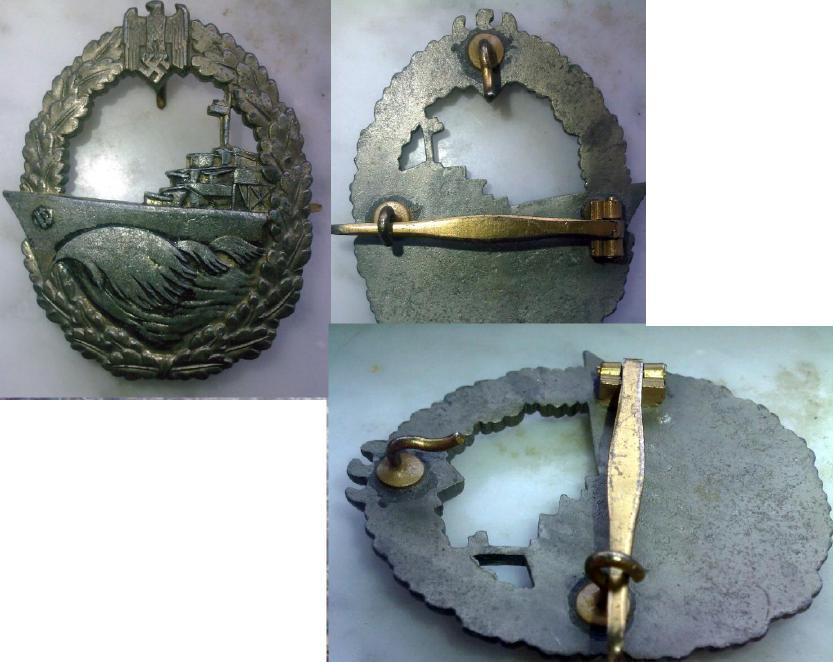 0
0 -
And here's something quite interesting.
Two S&L tombak Destroyer badges. The top one is maker marked "4" and has the same setup as the Collectors Guild U-boat, and the bottom one is non-maker marked and has the same setup as Michel's badge.
Best regards,
---Norm
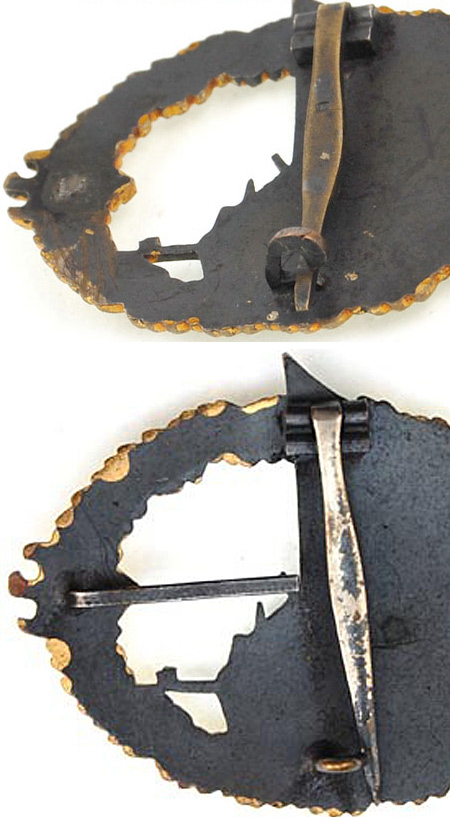 0
0 -
I think the badge displays a very similar reverse set up as K&Q EKI's,especially with the "C"-wire catch.
Regards,Martin.
Hi Martin,
The K&Q EK1s that I've found all have the round wire "C" catch not the ?-shape catch (see attached). Likewise I couldn't find other W&L badges yet with this catch. S&L used the ?-shape catch quite frequently however.
I realize that this is only one factor to consider, and we still don't know if there was some working relationship between S&L and W&L.
Best regards,
---Norm
 0
0 -
Yes. You can see both the straps and the cuffband on this shot.
The original tranche of personnel to set up the Marine Küstenpolizei came from the civil Wasserschutzpolizei, and in the same way those transferred from the Motorisierte Gendarmerie to help form the Feldgendarmerie initially wore their police uniforms for a short period, so the ex Wasserschutzpolizei personnel wore their WSP uniforms before changing to KM issue dress.
Thanks very much Gordon for this historical perspective. The breadth of your research is formidable! So in this photo it seems to be a KM issue blue uniform; is that insignia of the national symbol on the upper arm specific to the MKP or the WSP? And does it replace the standard left breast insignia or is it in addition to...?
Cheers.
---Norm
0




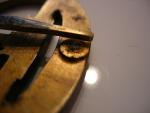
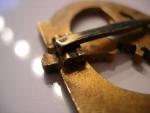
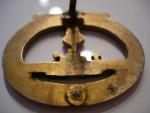
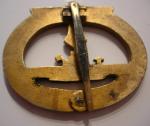
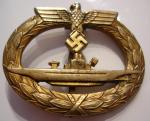

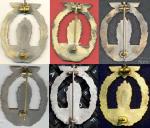
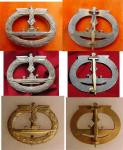
Kreigsmarine Breast Eagle
in Germany: Third Reich: Uniforms, Headwear, Insignia & Equipment
Posted
Hi Dan,
The maker is J.C. Maedicke, Berlin. This is the eagle for the officers' white summer uniform.
Best regards,
---Norm